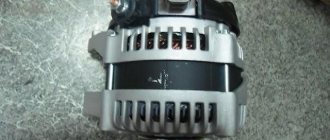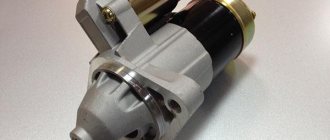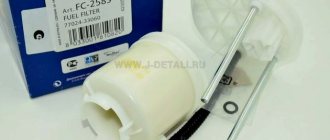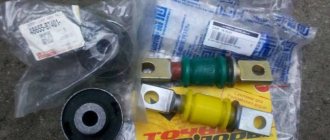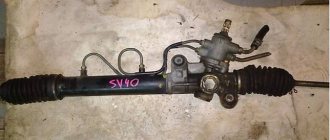Reason for removing the radiator of Toyota Camry V40 3.5 l. — coolant leaks from the connection between the plastic part of the radiator and the aluminum honeycomb. The leaks were not constant, but only when the engine was well warmed up, when the antifreeze was hot and under high pressure.
Usually aluminum radiators cannot be repaired, but not in our case. There were craftsmen who decided to repair this radiator, securing the rupture site with clamps and special glue. If there are no such craftsmen in your city, then you will have to replace the radiator with a new one. Or, as a temporary solution, use radiator sealant.
Main malfunctions of the Toyota Camry heater
The design of the heating system of any modern car is based on a single concept, which involves the use of coolant as a coolant, which is heated in the engine and gives off its heat directly to the stove. The heater radiator in this scheme plays the role of a heat exchanger, removing heat from the antifreeze and heating the air flow directed into the cabin.
In this regard, all malfunctions related to poor operation of the stove can be divided into two large classes:
- breakdowns leading to problems with coolant circulation;
- problems with the functioning of components related directly to the heater unit.
Since the first category of faults is associated not so much with the operation of the climate system, but with the deterioration of the functioning of the cooling system of the power unit and has many early diagnostic tools, we will consider them only partially, focusing mainly on the second class of faults.
Heater core replacement process
We list the main reasons leading to a significant deterioration in interior heating:
- the entry of foreign objects into the cooling system line, as well as the formation of air pockets (a consequence of imperfect design of the heat exchanger and the system of coolant supply and return pipes). Obstacles that arise along the path of antifreeze lead to a decrease in heat transfer from the stove;
- depressurization of the stove radiator resulting from mechanical damage (corrosion, natural wear and tear, the result of an accident or the consequences of a previous repair). The result is a drop in the temperature of the air flow supplied to the deflectors to 30-35°C;
- antifreeze is contaminated to such an extent that it ceases to perform its immediate functions in full;
- the heater radiator is clogged and is unable to ensure a normal heat exchange process;
- There are problems with the operation of the fan blowing air into the cabin.
About half of the possible malfunctions of the standard heater require dismantling, repairing or replacing the Camry 40 heater radiator.
This is interesting: Citroen Xanthia brake discs: selection and replacement
How to replace a radiator on a Toyota Camry
- Unscrew and remove the plastic air intake pipes
- Drain the coolant from the radiator
- Disconnect all pipes and electrical connectors from the top of the radiator
- Unscrew the upper radiator mounting beam
- We take out the cooling system fans
- Unscrew all the lower pipes from the radiator
- Disconnect the air conditioner radiator from the main radiator
- We take out the cooling radiator
- We repair it or replace it with a new one
- Putting everything back together in reverse order
Signs of a heater malfunction
Failures of the Toyota Camry heating system are not always completely destructive. In most cases, problems appear gradually, so it is often not possible to diagnose the problem in time. Partially, the seasonality of using the stove, which is practically not used during the warm season, helps to notice the malfunction. With the onset of cold weather, the deterioration in the efficiency of the heater becomes especially noticeable, however, there are a number of symptoms that can be used to diagnose problems in the operation of a particular stove unit in advance:
- deterioration of interior airflow (air flow power decreases noticeably);
- switching heating modes on the center console has no effect - the air temperature remains unchanged;
- extraneous sounds are heard from the area where the stove is located;
- the windows in the cabin begin to fog up frequently and for no reason (even opening the windows does not help in the summer);
- the appearance of unpleasant odors and increased dustiness is another symptom indicating a malfunction of the radiator or critical contamination of the cabin filter.
In all of the above cases, it will be necessary to disassemble the heater and remove the stove or fan. In a Toyota Camry, the heater is located in the central part of the dashboard, located directly under the instrument panel and shifted towards the glove box. This location can generally be called standard, used by most automakers. But at the same time, there are features regarding the location of an extensive system of air ducts and deflectors that create problems when performing operations related to the maintenance and repair of heater components.
At the same time, the automaker's designers tried not to deviate from the general concept of building a heating system. Thus, the aluminum radiator is enclosed in a plastic case, the damper arrangement is standard for all modifications. Contact connectors for power supply to the stove components are also made in accordance with industry standards.
Disassembled interior heater
Partial repair or replacement
If the car is under warranty service, if troubles arise with the stove, the question of self-repair loses its relevance. It is clear that heater breakdowns during the initial period of Camry operation are rare, and in most cases this is the result of a manufacturing defect.
But the bulk of malfunctions occur later, when the car is no longer under warranty, and in this case the causes of breakdowns are natural (wear, clogging) or caused by improper operation.
Correct diagnostics of the cooling and heating system is of great importance when the efficiency of the heater decreases. The primary method of checking is a visual inspection of the coolant circulation line for leaks, including, of course, the heater components.
If there are problems with the operation of the furnace fan, checking the integrity of the electrical wiring comes to the fore, requiring minimal skills in using instrumentation.
The condition of components such as the radiator and/or heater fan is determined after their removal. At this stage, we can conclude that it is advisable to perform a partial repair that restores the functionality of the device, or that it is necessary to replace the unit with a new one due to the impossibility of its restoration for one reason or another (complexity, lack of necessary tools, inability to purchase suitable spare parts/components).
In any case, by performing a range of repair work yourself, you will save a significant amount of money, which can be spent on purchasing high-quality consumables and original spare parts.
Here is a table of the estimated cost of the original components of the Toyota Camry heating system:
| Node name | Catalog number | Approximate cost, rub. |
| Furnace fan assembly with electric motor (2ARFE/2GRFE/2ARFXE, 1ARFE, 6ARFSE) | 87107-33120 | 4000 and above |
| STTYL53950 | analogue | From 2000 |
| Servo motor | 33136 | From 2500 |
| Pump for hybrid modification of Toyota Camry CB40 | 41746 | From 5800 |
| Stove assembly | 22241 | From 6000 |
| Camry 40 climate control unit | 22242 | From 5300 |
| Servo motor option for right-hand drive modifications | 4113542 | From 2700 |
The cost of spare parts largely depends on the region - in the east they are minimal, repairs will cost the most in the capital and St. Petersburg.
New heater radiator
Warning
Remove the radiator only when the engine is cold.
- You will need: a 10" wrench, pliers with long thin jaws, a flat-blade screwdriver.
- Drain the coolant (see “Replacing the coolant”).
- Disconnect the main fan wiring harness connector by pressing the spring clip.
- Similarly, disconnect the wiring harness connector for the additional electric fan.
- Loosen the clamp securing the steam exhaust hose to the expansion tank by squeezing its bent ears with pliers, slide the clamp along the hose and remove the hose from the radiator pipe.
- Loosen the clamp securing the supply hose and disconnect the hose from the radiator pipe.
- Similarly, disconnect the outlet hose from the water distribution pipe.
- Unscrew the bolt securing the upper radiator support bracket to the upper cross member of the radiator frame and remove the bracket as an assembly with the upper support pad.
- Similarly, remove the second upper radiator support.
- Remove the radiator assembly with electric fans from the engine compartment.
- Remove them from the crossmember if they remain in the crossmember holes, or remove them from the pins and inspect them.
- Replace heavily compressed or hardened cushions.
- Similarly, remove the cushions from the upper support brackets, inspect them and replace them if necessary.
- If you removed the radiator for repair or replacement, loosen the bleeder hose clamp and remove the hose.
- Unscrew the three bolts securing the main electric fan casing to the radiator and remove the electric fan assembly with the casing, removing the lower right support of the casing from the bracket on the radiator.
- Unscrew the two bolts securing the additional electric fan casing to the radiator and remove the electric fan assembly with the casing, removing the lower casing supports from the brackets on the radiator.
- Rinse the outside of the radiator with running water and dry. If there are cracks in the plastic radiator tanks, replace the radiator.
- Check the tightness of the radiator by plugging the radiator pipes, supplying it with air under a pressure of 0.1 MPa (1 kgf/cm2) and lowering it into a container of water for at least 30 s. Radiator leaks are determined by escaping air bubbles. If the radiator does not fit completely into the container, check it sequentially from all sides.
- Install the electric fans and exhaust hose onto the radiator in the reverse order of removal.
- Install the radiator on the car in the reverse order of removal.
- Fill in the coolant and remove any air pockets from the cooling system (see “Replacing the coolant”).
admin2017-04-22T22:25:59+03:00
How to remove radiator for Toyota Camry, replacement, diagram
How to remove the radiator on Camry 40
The radiator is ready for cleaning. It is enough to connect a hose to the tap and fill the radiator with water, draining it afterwards. The process must be repeated until crystal clear water begins to pour out of the radiator.
The lower valve closes and coolant is poured into the radiator. It is recommended to wait a few minutes after filling so that the cooling system has time to evenly distribute all the liquid within itself.
Then the bubbles of accidentally trapped air will rise up. They can be easily removed by gradually adding liquid through the radiator neck; the location of the neck is indicated in the photo.
Radiator Camry 40
Do not forget that if antifreeze is used as a refrigerant, then it must be selected according to all the necessary parameters. To finally check the circulation of the system, you need to heat the liquid to maximum power.
Don't worry if the plug starts venting steam. This is a normal phenomenon, therefore, when starting the engine for the first time after changing the fluid, you should not tighten the neck cap all the way. radiator for Toyota Camry
Replacing the radiator with a new one If the radiator fails, you will have to replace it. In this case, you cannot do without wire cutters, a screwdriver and keys: You should immediately note that you should not throw away the old radiator, since the price of a new radiator is for a Toyota Camry, and therefore the old one can be soldered.
Even if it no longer makes sense to use it in a car, you can sell it to craftsmen at a profit. They often use it instead of a coil in moonshine stills.
Dismantling begins with disconnecting the battery. Then you need to remove the steering wheel by unscrewing the nut 24 and pull out the air duct grille. After this, you can begin to unwind the storage shelf and lining. After the radiator work on the Toyota Camry is completed, all that remains is to unscrew the screws of the glove compartment, the switches and nozzles located under the steering wheel.
Afterwards, unscrew the torpedo bolts. It can be pulled out for subsequent disconnection of the air ducts located on the side, as well as electrical connectors and tightening the clamps from the stove radiator.
Usually there is a lot of debris under the radiator, which also needs to be removed, since it can interfere with installation in the future.
Installation diagram for a new radiator The new radiator must be installed in the reverse order relative to the diagram for disassembling and removing the old one.
We use 10mm and 12mm open-end wrenches. Unclip the three top diffuser mounts.
Disconnect the lower radiator pipe. We unscrew the metal automatic transmission oil cooling pipe with a 19mm wrench and the mounting bolt that supports this tube with a 10mm wrench.
Radiator flushing
To start flushing the radiator, you need to prepare the following:
- liquid for cooling an internal combustion engine (antifreeze in the winter season, water in the summer);
- rinsing agent;
- hose;
- bucket;
- a set of wrenches and screwdrivers;
- flushing agent;
- pan for drainage;
- containers;
- It is advisable to use safety glasses for working with antifreeze.
Flushing is carried out exclusively when the engine has cooled, and it does not matter what version it is: 2.4 or 3.5. Then open the hood lid and fasten it securely. Then, with water and added cleaning agents, wash all components from dust and dirt, as well as traces of machine oil.
Don't forget about toxicity
If antifreeze was used as a coolant, it should not be poured onto the ground. It is necessary to use a pan for drainage. They place it under the radiator valve, open it and wait until all the liquid there is drained.
After this, you can begin checking the lid for tightness and ability to withstand increased pressure. As a rule, the cover is checked visually. If it is leaking, it is better to replace it without waiting for the problems associated with this to grow in the future.
Installation diagram for a new radiator
The new radiator must be installed in the reverse order of the disassembly and removal of the old one. At the same time, it is strictly forbidden to reuse coolant, since over time, sediment can clog the thin radiator tubes, which can subsequently lead to overheating of the entire system.
It is recommended to treat the edges of the sockets with sealant and let it harden. This will protect the system from leaks and will save you a lot of time and nerves in the future, because if a leak is detected, you will have to repeat all the procedures again.
The serviceability of the cooling system should be taken no less seriously than the other components and assemblies of the Toyota Camry 40. After all, a malfunction can lead to general overheating of the engine, and subsequently more serious consequences.
High-quality and timely maintenance will allow you to use the car for many years without the need for major repairs, and as a result, without large financial investments.
Payment via Yandex Cashier
After selecting payment via Yandex, the Yandex Cashier payment system will launch, where you need to select a convenient payment method (bank card, QIWI, Yandex Money account, etc.)
After specifying payment details and confirming payment, payment for the goods will occur.
If you have a bank card in a currency other than the ruble, then the money will be debited from the card at the rate of the Central Bank of Russia at the time of the purchase.
This payment method is optimal for residents of Russia, Kazakhstan and Belarus.
Payment via Portmone
After selecting payment through Portmone, the payment system will launch, where you need to select the payment method: bank card or Portmone account.
The price in the Portmone payment system is converted into dollars at the exchange rate of the Central Bank of the country where you are located.
If you have a bank card in a currency other than the dollar, then the money will be debited from the card at the rate of the Central Bank of your country at the time of the purchase.
After specifying payment details and confirming payment, payment for the goods will occur.
Payment via PayPal
After selecting payment via PayPal, the PayPal payment system will launch, where you need to select the payment method: bank card or PayPal account.
If you already have a PayPal account, then you need to log into it and make a payment.
If you do not have a PayPal account and you want to pay using a bank card via PayPal, you need to click on the “Create an Account” button - shown with an arrow in the picture.
PayPal will then prompt you to select your country and provide your credit card information.
After specifying the information required to make the payment, you must click on the “Pay Now” button.
Payment via WebMoney
After selecting payment via WebMoney, the payment system will launch, where you need to select the payment method: bank card or WebMoney wallet.
If you already have a WebMoney wallet, then you need to log into it and make a payment.
If you do not have a WebMoney wallet and you want to pay in another way, you need to select any of the methods that WebMoney offers and make the payment
After specifying payment details and confirming payment, payment for the goods will occur.
Downloading a book
After successfully completing the payment (by any method) and returning to the KrutilVertel store from the payment system website, you will be taken to the successful payment page:
On this page you need to indicate your e-mail, where access to download the book will be sent.
If you are already registered on our website, then simply follow the link to your personal account.
The book you purchased will be in your personal account, from where you can always download it.
Please note that after making the payment, you need to return back from the payment system website to the KrutilVertel website.
If for some reason you did not return back to the site and closed the payment system tab with a message about the successful completion of the payment, please let us know - we will send you a letter indicating access to download the book.
Problems when paying with bank cards
Sometimes difficulties may arise when paying with Visa/MasterCard bank cards. The most common of them:
- There is a restriction on the card for paying for online purchases
- A plastic card is not intended for making payments online.
- The plastic card is not activated for making payments online.
- There are not enough funds on the plastic card.
In order to solve these problems, you need to call or write to the technical support of the bank where you are served. Bank specialists will help you resolve them and make payments.
That's basically it. The entire process of paying for a book in PDF format on car repair on our website takes 1-2 minutes.
Features of flushing work
What is required to carry out the cleaning procedure for this mechanism:
- antifreeze for Camry 2007;
- distilled water;
- coolant;
- cleaning agent;
- pan for drainage;
- bucket;
- hose;
- safety glasses for working with Camry 50 2007;
- containers;
- screwdrivers and wrenches.
Next, the whole process is carried out in stages, because the engine cooling radiator of the Model 50 requires considerable attention:
- Wait until the engine cools down before cleaning the radiator: the hood must be securely secured to prevent accidental falls; soapy water is used to remove dirt elements.
- Used coolant must be disposed of properly as it is toxic. It is necessary to use a drainage pan that is placed under the car - a valve that has an engine cooling radiator.
- Check the cap to ensure that optimal pressure is maintained.
If it can easily be compressed with a couple of steps, it's time to think about replacing it.
How to choose a cooling radiator for Toyota Camry V40 3.5
When purchasing, be guided by your capabilities. If the budget is not limited, then the original can be used, but when you can only spend a certain amount, then it is better to give preference to a radiator from Nissent or a budget Thermal.
| Manufacturer | vendor code | Average price, rub. |
| Original | ||
| TOYOTA LEXUS | 1640031520 | 24600 |
| Analogs | ||
| SAT | TY0003GSV40 | 4800 |
| TERMAL | 2846812X | 5000 |
| NISSENS | 646812 | 11700 |
The antifreeze that you fill in to replace the old one must correspond to class G12, or use the original Toyota. The volume of the cooling system in Camry 40 is 9 liters.
Tools required for work
- Wrenches for 10mm, 12mm, and 19mm;
- Screwdrivers “+” and “-“;
- Pliers;
Element replacement work
Regardless of the year of manufacture of the car (2007 or any other), it is necessary to regularly carry out work to repair important elements and replace them.
To carry out measures to clean the radiator, you will need keys 8–10, 13–14, 24, a screwdriver and wire cutters. After this, you need to do a number of things to change the element.
Basic actions to be performed:
- The process begins by disconnecting the battery.
- Removing the steering wheel and unscrewing the nut 24.
- Removal of decorative air duct grilles.
- Unscrewing the screws of the trim and storage shelf.
- Next, you need to remove the screws securing the glove compartment, nozzles, and switches under the steering wheel.
- Disabling the torpedo bolts on both sides and removing it.
- Disconnecting air ducts from the side.
- Tightening the heater radiator clamps.
- Disconnecting electrical connectors.
After you have managed to remove the structure of the original radiator on a 2007 Camry 40 or 50, you can see a lot of debris that needs to be gotten rid of.
Replacing the radiator with a new one
If the radiator fails, it will have to be replaced. In this case, you cannot do without wire cutters, a screwdriver and keys: 8-10, 24, 13-14.
You should immediately note that you should not throw away the old radiator, since the price of a new one is high, and therefore the old one can be soldered.
Even if it no longer makes sense to use it in a car, you can sell it to craftsmen at a profit. They often use it instead of a coil in moonshine stills.
Dismantling begins with disconnecting the battery. Then you need to remove the steering wheel by unscrewing the nut 24 and pull out the air duct grille. After this, you can begin to unwind the storage shelf and lining. After this work is completed, all that remains is to unscrew the screws of the glove compartment, the switches and nozzles located under the steering wheel.
Afterwards, unscrew the torpedo bolts. It can be pulled out for subsequent disconnection of the air ducts located on the side, as well as electrical connectors and tightening the clamps from the stove radiator.
Usually there is a lot of debris under the radiator, which also needs to be removed, since it can interfere with installation in the future.
Alternative to the original
At the same time, car owners are increasingly replacing parts with similar ones, using full or partial chrome plating. This practice is due not only to the best external visual properties for many models, including the V50 and V55, but also to the level of wear resistance characteristics.
A chrome radiator grille, made using modern technologies, will serve for a long time, without the risk of losing its aesthetic properties.
In addition to the unique ones, the market also offers brilliant and ordinary versions of parts for the V50, V55 models, produced in other countries, but slightly inferior in quality to genuine grilles:
Toyota Camry 40 removal of engine cooling radiator
As it turns out, it’s just a Toyota Camry 40
- a whole story! And we decided.
Toyota Vista engine cooling radiator replacement
This video shows how to replace the radiator
on a
Toyota Vista , the radiator
is a duplicate of the SAT office.
- China – TYCAM11-101 (V50), TYCAM14-100 (V55);
- Taiwan – TYCAM11-4C0 (V50), TYCAM97-100HB (V55).
How to remove the radiator on Camry 40
- 139 6 120k
- 229 5 251k
Reason for removing the radiator of Toyota Camry V40 3.5 l.
— coolant leaks from the connection between the plastic part of the radiator and the aluminum honeycomb. The leaks were not constant, but only when the engine was well warmed up, when the antifreeze was hot and under high pressure. Usually aluminum radiators cannot be repaired, but not in our case. There were craftsmen who decided to repair this radiator, securing the rupture site with clamps and special glue. If there are no such craftsmen in your city, then you will have to replace the radiator with a new one. Or, as a temporary solution, use radiator sealant.
Installation procedure
Any car enthusiast with sufficient rank for this and the ability to use a simple tool can remove The experts recommend the following sequence of work.
- Open the car hood.
- Detach the plastic cover by releasing the fastenings of the clips by pressing on their middle part, followed by its removal.
- Specifically, they begin to dismantle the element attached to the clip, screws and guides. A total of 8 latches and 10 guides are located around the perimeter.
- The upcoming step requires special attention when removing the element from the guides. With all this, dismantling the side guides is not difficult, but with the bottom it is more difficult due to the awkward position for access. When carrying out this procedure, they use plastic plates (like bank cards) or other similar devices. They will ensure accurate removal without breaking the fasteners.
- You need to shoot with a smooth movement towards yourself.
- Installation is carried out in the opposite sequence to disassembly.
How to replace the radiator of the cooling system of a Toyota Camry
We remove the car radiator for replacement, as well as for washing and repair.
We prepare the car and install it on a lift or inspection ditch.
Disconnect the negative terminal of the battery
Removing the lower engine mudguards
Disconnect the steam pipe from the radiator filler neck
We remove the electric radiator fans, as described in the previous article
We loosen the clamp securing the radiator outlet hose by squeezing its bent ears with pliers, and slide the clamp along the hose
Remove the hose from the radiator pipe
The radiator supply hose was disconnected before removing the electric fans.
Disconnect the hoses from the pipes of the automatic transmission heat exchanger built into the radiator
Disconnect the wire connectors from both sound signals
We unscrew the three bolts securing the hood lock and remove the lock from the upper radiator bracket
Release the hood lock drive cable from the holder on the upper radiator bracket
We unscrew the four bolts securing the upper radiator bracket to the body (two each on the right and left)
Unscrew the bolt securing the upper radiator bracket to the hood lock bracket
Remove the upper radiator bracket and two rubber pads of the upper radiator supports
We unscrew the two lower and two upper bolts securing the radiator of the air conditioning system to the radiator of the engine cooling system
Remove the engine cooling radiator from the engine compartment
Remove the two rubber cushions of the lower radiator supports
We inspect the support pads, if they are hardened or deformed, replace them
We rinse the radiator with a stream of water and dry it. If cracks appear on the plastic radiator tanks, replace the radiator
We check the tightness of the radiator by turning off its pipes.
We supply air under a pressure of 0.1 MPa (1 kgf/cm2) to the radiator and lower it into a container of water for at least 30 seconds. We determine the leakage of the radiator by the output air bubbles.
Install the radiator and all parts in reverse order
Before installing the hoses, lubricate the pipes with a thin layer of sealant
Source
Alternative to the original
At the same time, car owners are increasingly replacing parts with similar ones, using full or partial chrome plating. This practice is due not only to the best external visual properties for many models, including the V50 and V55, but also to the level of wear resistance characteristics.
A chrome radiator grille, made using modern technologies, will serve for a long time, without the risk of losing its aesthetic properties.
In addition to the unique ones, the market also offers brilliant and ordinary versions of parts for the V50, V55 models, produced in other countries, but slightly inferior in quality to genuine grilles:
Toyota Camry 40 removal of engine cooling radiator
As it turns out, it’s just a Toyota Camry 40
- a whole story! And we decided.
Toyota Vista engine cooling radiator replacement
This video shows how to replace the radiator
on a
Toyota Vista , the radiator
is a duplicate of the SAT office.
- China – TYCAM11-101 (V50), TYCAM14-100 (V55);
- Taiwan – TYCAM11-4C0 (V50), TYCAM97-100HB (V55).
